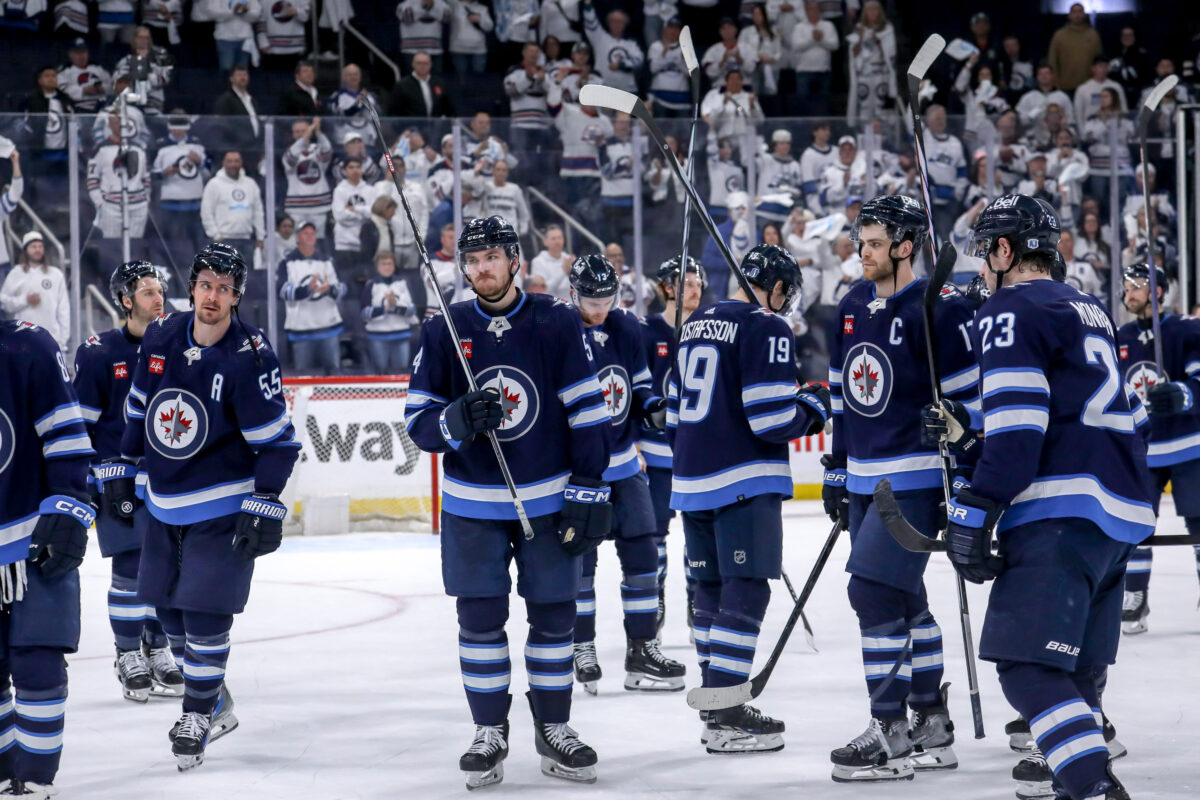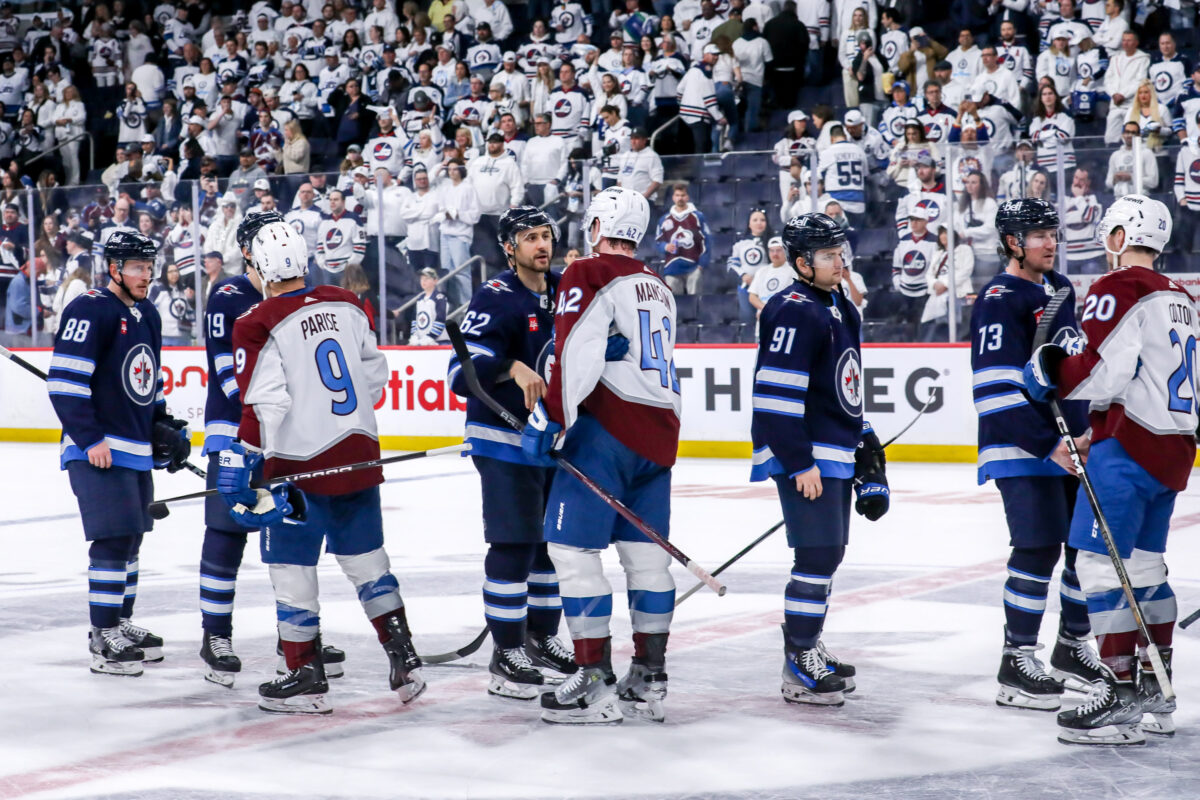It wasn’t long, but it sure was painful.
The Winnipeg Jets were reverse swept by the Colorado Avalanche after winning Game 1 and have made another first-round exit. Most thought the series between the Central Division’s number-two and number-three seeds — separated by only three points in the standings — would be highly competitive, but it turned out to be a mismatch.
Related: Avalanche Outduel Jets 6-3 in Game 5, Take Series 4-1
The Jets, despite having home-ice advantage and defeating the Avalanche all three times in the season series, were soundly dominated and looked more like a Draft Lottery team than one that was fourth in the league with 52 wins and looked poised to make a Stanley Cup run.
Now that we’ve got the cadaver, it’s time to do the autopsy. Here, we’ll take a look at everything that went so wrong.
Jets Couldn’t Keep Up With Avalanche’s Speed or Play Solid Defence
With the Avalanche having the league’s leading offense and the Jets having allowed the fewest goals in the league, the series looked poised to be an “unstoppable force meets an unmovable object” type of scenario, but it didn’t turn out that way.
The Avalanche’s offence — led by Nathan MacKinnon, Mikko Rantanen, and Cale Makar — ran roughshod, completely exploiting and dismantling Jets’ defensive structure by coming at them with breakneck speed. The Jets were never able to find a way to stave off the relentless attack for more than a few minutes at a time, and after winning the William M. Jennings Trophy in the regular season and having a stretch of 34-straight games they allowed three or fewer goals, set an inauspicious record of being the first team in NHL playoff history to give up five-plus goals in each of their first five games.

The Avalanche succeeded at nearly every zone exit attempt and experienced little adversity in entering the offensive zone with speed and puck possession as the Jets’ usually-excellent forecheck was non-existent. This, along with the Jets’ many turnovers, led to a boatload of high-danger chances both on the rush and on the cycle due to extended zone time.
Jets’ Discipline & Penalty Killing Was Poor
The Jets entered the matchup at a disadvantage at special teams as the Avalanche came in with the league’s fifth-best power play and the Jets came in with the league’s 22nd-best penalty kill. The Jets knew, to be successful, they would have to stay out of the box.
Unfortunately, they cut ruts to the sin bin. Some penalties were because they couldn’t handle the Avalanche’s speed off the rush or because they got hemmed in the defensive zone for extended periods, while others were because they lost their cool or did downright stupid things. Regardless, the Avs made them pay for their indiscretions, going six for 16 on the man advantage for a 37.5 per cent efficiency and using their prowess to turn close games into laughers.
The Jets gave up two power-play goals in the third period of Game 1 and managed to escape with a 7-6 victory but the penalty-killing woes that dogged them for most of the regular season loomed larger as the series went deeper.
The Jets took four-straight penalties in the third period of Game 3, and the Avalanche turned a 2-1 deficit into a 3-2 lead with power-play goals just 2:38 apart on the Jets’ first two infractions. The Jets took four penalties in the second period of Game 4 — a period they came into tied 1-1 — and allowed goals on two of their attempted kills.
Hellebuyck Wasn’t Nearly at His Best
Discourse about Connor Hellebuyck through the series was firmly divided into two camps: one deemed him completely at fault, while the other deemed him completely blameless for any pucks past him.
The reality falls somewhere in between: the defense in front of him didn’t do him any favours, allowing way more high-danger chances and a far greater expected goals against than they did in the regular season, but Hellebuyck also wasn’t nearly at his best.
The Jets, on paper, seemed to have a big advantage in the crease as Hellebuyck is the likely 2024 Vezina winner and Avalanche goaltender Alexandar Georgiev struggled at times during the regular season. That on-paper advantage never materialized on the ice.
Hellebuyck looked shaky from the get-go and failed to come up with big saves at key times, which often turn the tide of momentum in short series. He gave up 19 goals through the first four games — the most of any four-game stretch in his entire nine-season career — and finished with 24 goals against, an ugly 5.23 goals against average (GAA) .870 SV%, and a negative 5.0 goals saves above expected (GSAx.) That negative 5.0 GSAx number is most revealing of his struggles.
That comes after he posted a 2.39 GAA, .921 SV%, and 33.1 GSAx in 60 regular-season starts. Even his greatest apologists have to admit he was subpar under the brightest lights and that his recent playoff series performances are cause for concern — he has allowed three-plus goals in nine-straight playoff games. He refused to speak to reporters any time after Game 1, so we’ll have to wait until exit interviews Thursday to hear his thoughts.
Bowness’ Player Usage & Lines Were Questionable
Rick Bowness, after general manager Kevin Cheveldayoff added Sean Monahan and Tyler Toffoli to an already-balanced group up front, had the deepest group of forwards in the 2.0 era at his disposal.
While the group certainly didn’t execute at a high enough level and must take some blame for that, Bowness failed to set them up for success. He seemed at a bit of a loss at how to best deploy the talent — continuing a trend from late in the regular season — and made a number of strange lineup and player deployment decisions.
Bowness did not make any change (other than in garbage time) to his forward lines until Game 5. His new-look lines of Ehlers/Scheifele/Vilardi, Connor/Monahan/Perfetti, Niederreiter/Lowry/Appleton, and Iafallo/Gustafsson/Toffoli, played fairly well through two periods of the elimination game but were behind 3-2.
In the third, Bowness cut the lines down to three and shuffled them back to the previous combinations. After Toffoli scored to tie the game 3-3, they gave up two-straight even-strength goals, which were the final nails in the coffin. The reason for the change, Bowness said after the game, was he felt the lines were just “doing okay” and he wanted to generate more offence.
Just as controversial as where Bowness played players is who he played and who he sat. Cole Perfetti, who scored 19 goals and recorded 38 points the regular season, was a press-box resident until Game 5, with David Gustafsson and Axel Jonsson-Fjallby both getting playing time ahead of him in the fourth-line spot vacated by the injured Morgan Barron. Perfetti was a frequent healthy scratch down the stretch as well and one has to wonder if the relationship between player and coach is fractured.
On the back end, Neal Pionk was a liability throughout the series but remained in the top four for all five games. When Brenden Dillon suffered a cut to his hand in a big scrum at the end of Game 3 that kept him out for Games 4 and 5, Logan Stanley got the call instead of Colin Miller for Game 4. Stanley, who struggled in Games 1 and 2 before being replaced by Nate Schmidt for Game 3, committed a number of egregious turnovers and took two-straight penalties in his return.
Miller, acquired at the trade deadline as a potential upgrade over Pionk or Stanley, didn’t play until Game 5 and only played in five regular-season games for the Jets.
Laurent Brossoit only got in for the third period of Game 4, when the Jets were already losing 4-1, despite Hellebuyck’s struggles. Brossoit had a stellar season in his own right, posting a 15-5-2 record in 22 starts and 23 appearances, tidy 2.00 GAA, .927 SV%, and three shutouts, but never got the chance to show what he could do with the Jets in the playoffs rather than against them as he did last spring.
Jets Fell Apart in Back Halves
The Jets never came close to putting together a 60-minute effort in the series. Believe it or not, however, they were either ahead or tied at the midway point in all four losses; each time, unraveled in the back halves after they made one mistake that compounded into many.
The Jets were leading 2-1 in Game 2 until 14:16 of the second period, but allowed four straight to lose 5-2, and they were leading 2-1 in Game 3 until 2:11 of the third, when they allowed five straight to lose 6-2. Game 4 was tied 1-1 until 11:26 of the second period, when they allowed four straight and lost 5-1, while Game 5 was tied 2-2 until 13:45 of the second period, after which the Avalanche outscored the Jets 4-1 and won 6-3 to finish off the series.
Jets Suddenly Have Bunch of Question Marks After Another Early Exit
As we said at the top, the Jets tied a 2.0 record with 52 regular-season wins, but teams don’t become legends, talked about in reverent tones years later, for what they did in the regular season.
The Jets aren’t the first good team in recent NHL history to be dispatched in the first round — the 2020 Tampa Bay Lightning, last season’s historic Boston Bruins, and all but one Toronto Maple Leafs’ squad in the past 20 years all come to mind — nor is their contention window closed. However, it’s disappointing given the window never appeared more open given the personnel Cheveldayoff added in hopes of making a deep run and also because we know the Jets, at their best, could have made that deep run. It’s “another year that feels like a missed opportunity,” Josh Morrissey said after being eliminated.

The second-straight first-round exit, which leaves the Jets stuck at just three playoff series wins in 13 seasons since relocation, has rightfully raised a bunch of questions. Does their current core — Adam Lowry, Mark Scheifele, Kyle Connor, Nikolaj Ehlers Morrissey, Hellebuyck, and a few others — have enough character and resilience to shine in key moments and be more than playoff also-rans? If they do, they haven’t shown it yet.
Is Bowness a modern-enough coach to lead the team into the future, or has he and sometimes old-school tactics taken them as far as he can? How will the fanbase — which seemed to be regaining some trust in True North Sports & Entertainment (TNSE) — react after what they just witnessed?
TNSE alienated fans last spring with their “Forever Winnipeg” advertising campaign many felt threatened relocation if ticket sales didn’t improve, but an increasing number were lured back down the stretch this season due to the on-ice product shining. The last thing TNSE needed was for the thing they had going for them most to drop off so drastically. Will fans vote with their wallets and use their entertainment dollars elsewhere next season, continuing attendance issues?
It’s a tough pill to swallow, but the reality is the Jets played worse in this spring’s playoffs than last spring’s, when they lost in five games to the Vegas Golden Knights and Bowness growled that he was disappointed and disgusted with his players’ lack of pushback in the elimination Game 5. There should be no shortage of self-reflection in the days to come, and hopefully, players and coaches alike will accept accountability to begin what will be a longer and more bitter offseason than expected.
“So it’s going to be a long summer, a disappointing one,” the captain Lowry said postgame. “This one’s going to sting for a while.”
